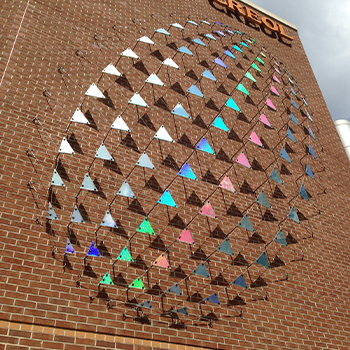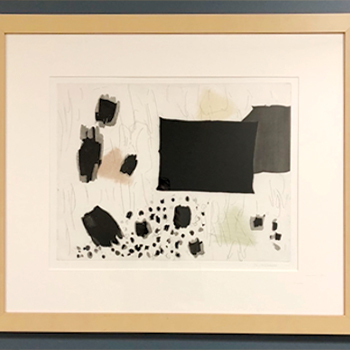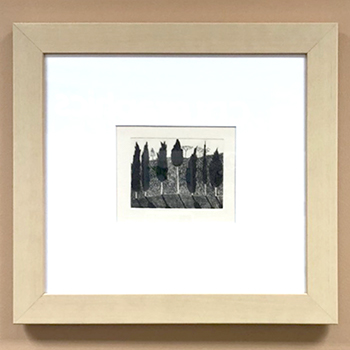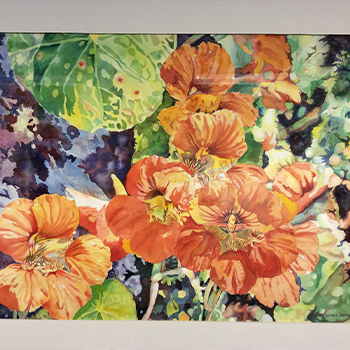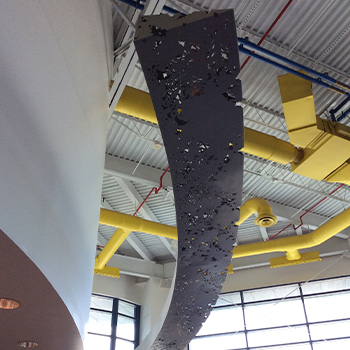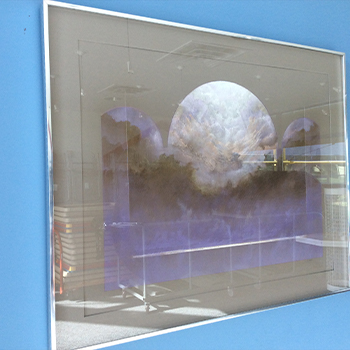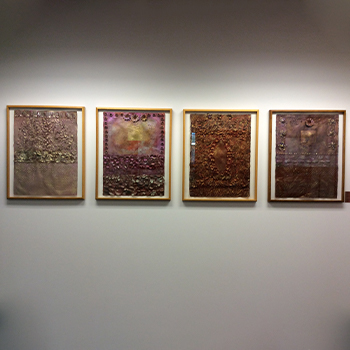

What is Public Art?
UCF Public Art is a diverse art collection including hundreds of small-scale portable artworks donated by collectors, 130 artworks in the Art in State Buildings program (AISB) and more than 65 artworks given to the University on long-term loan or as a gift by the Kottemann family.
Public Art enhances UCF’s campuses, connects the community with the University, and serves as a teaching tool. The art inspires, responds to areas of academic study, illustrates concepts, and stimulates conversation.

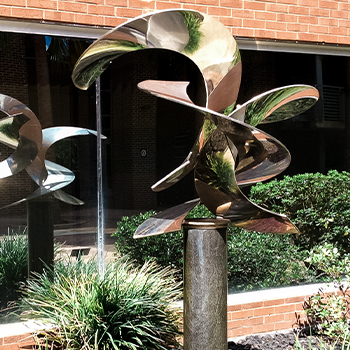
Logic at Random
Business Administration II
Logic at Random
Obie Simonis
Steel and granite
1992
Simonis states that “The spiral or helix has been a symbol of spiritual transformation throughout history and across cultural lines. It is the modern representation of biological transformation…the elegant simplicity of the pure spiral has inspired me throughout my career.”
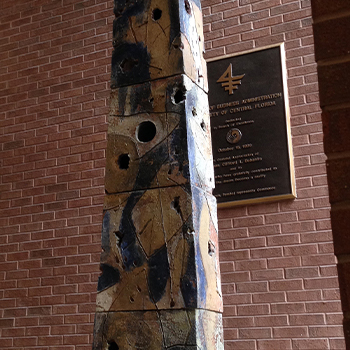
Monolith #1
Business Administration I
Monolith #1
John Balistreri
Ceramic
1997
Balistreri is best known for his large-scale ceramic sculpture as well as his innovations using digital technology to create ceramic objects using ceramic 3D printing techniques. He states that “My early work was a continuation of my involvement with the ancient process of wood firing. Since 1994, I began to concentrate on using this process in an attempt to make objects that resonate with age, both geologic and human.”
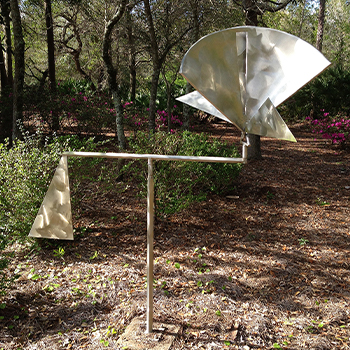
Gyratory II
Burnett House
Two Conical Segments: Gyratory II
George Rickey
Stainless steel
1979
Rickey is known for his kinetic works and was inspired by Alexander Calder’s mobiles. During WWII he learned about effects of wind while in the Army Air Corps maintaining computing instruments for gun-control turrets in B-29 bombers. In his sculptures like Gyratory II, the motion is achieved through the slightest variation in air currents and gravity using counterweights and ball bearings.
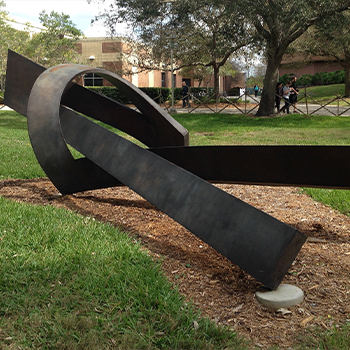
Alamar
UCF Bookstore
Alamar
Bruce White
Corten steel
1975-76
White’s work has been described as “an elegant union of ancient symbolism and contemporary science.” He does not usually begin with a specific idea in mind, but rather, relies on manipulation of paper or thin sheet of metal to generate a “surprise” solution which can only be fully realized in three dimensionally.
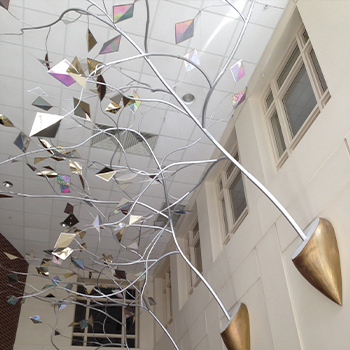
Tree Talk
Classroom I
Tree Talk
Melanie Walker and George Peters
Aluminum and PVC
2001
Walker and Peters “believe that public artwork should reflect a character of place, make a positive influence on the people that use and inhabit these areas, create an integrated platform for art in our public spaces and make our living, playing and working spaces a mix of color, culture and heart.”
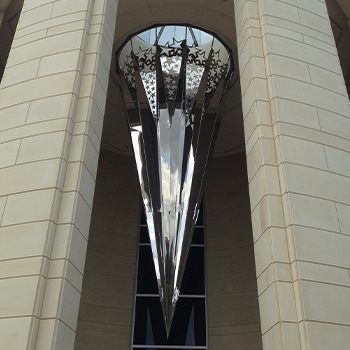
We See the Same Stars
Classroom II
We See the Same Stars
Malcolm Robertson
Solaglass
2013
This work is integrated with the design of the Classroom II building rotunda. Solaglass is stainless steel that has been polished to a mirror surface. Malcolm Robertson creates commissioned work from his studios in Scotland and Sarasota, Florida.
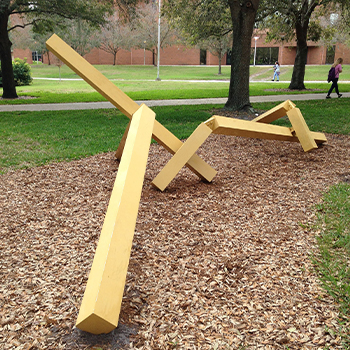
Sun Target #1
Colbourn Hall
Sun Target #1
Welded aluminum
1974
Sculptor John Henry is based in Chattanooga, TN. His works are described as “welded steel drawings” or “drawing in space”. Some of his sculptures, which are often monumental in size, have the appearance of floating despite the weight.
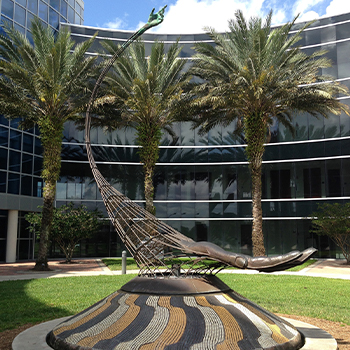
Enlightenment
Courtyard
Enlightenment
Don Reynolds
Mixed media fountain
2005
This sculpture has a water feature and can be rotated at the base. By pointing the hand in any direction, the art suggest different paths of enlightenment. In the words of the artist, “the willingness of the student reach out and take the hand of a mentor and allow the self to follow is basic to learning.”
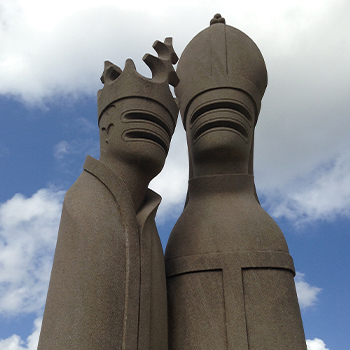
Bishop and Queen
Education Complex
Bishop and Queen
Nita Sunderland
Limestone
1990
Sunderland earned a bachelor’s degree from Bradley University and taught sculpture there for over 30 years. This work is from her “chessman” series of sculptures and reflects her ongoing interest in parallels between medieval and contemporary society.
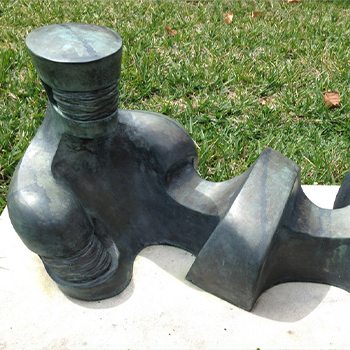
Recumbent Knight
Education Complex
Recumbent Knight
Nita Sunderland
Bronze
1990
Sunderland earned a bachelor’s degree from Bradley University and taught sculpture there for over 30 years. This work is from her “chessman” series of sculptures and reflects her ongoing interest in parallels between medieval and contemporary society.
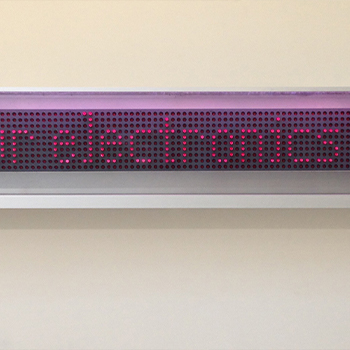
Lipstick Enigma
Harris Corporation Engineering Center
Lipstick Enigma
Janet Zweig
Computer driven sentence generator
2010
Lipstick Enigma is a language-generating machine that combines the jargon and syntax of fashion with the vocabulary of engineering to create new sentences that are displayed in lipstick-shaped pixels. The motors are powered by custom circuit boards that receive information from a computer that holds the Java program that drives the pixels and generates the sentences. A motion detector triggers the computer to write a new sentence and then display it.

Tree of Life
Health Sciences II
Tree of Life
Gretchen Lothrop
Stainless steel and bronze
2003
Lothrop states that “My process is additive, using predominately, but not exclusively, stainless steel. My imagery is often based on music or its corollary – dance, and the paradox of time. I think of my work as haiku – the crystallization of an instant of insight which might otherwise be swept away.”
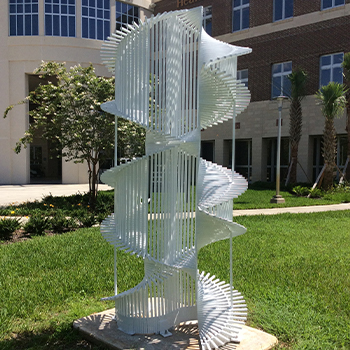
Space Waves II
Health Sciences I
Space Waves II
Linda Howard
Aluminum
1992
Howard is known for her large-scale outdoor sculptures, typically created with aluminum. Her process involves taking polished, wheel-ground, or white-painted square aluminum bars that are cut, assembled, and welded into elaborate geometric forms.
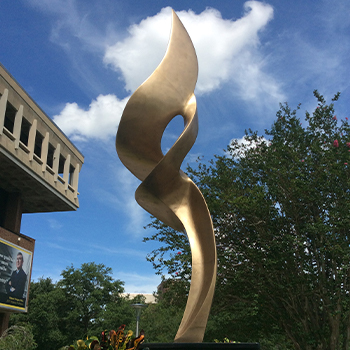
Flame of Hope
John C. Hitt Library
Flame of Hope
Leonardo Nierman
Bronze
1987
Leonardo Nierman was born in Mexico City in 1932. He started his career painting murals and his early work was influenced by Vasily Kandinsky, Paul Klee and Juan Miro. The Flame of Hope evokes movement and harmony through the use of the spiral form.
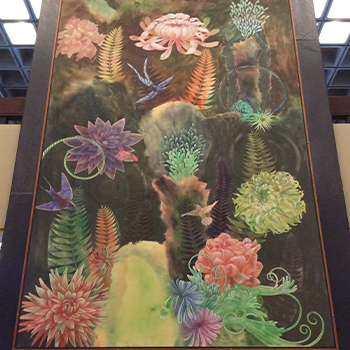
Florida Dream for UCF
Millican Hall
Florida Dream for UCF
Steve Lotz
Acrylic on canvas
1982
Lotz served as the first Chair of the UCF Art Department and is Professor Emeritus. He is known for his large-scale paintings such as this example and for his public art commissions. Lotz’s dreamlike images often depict imaginary and tropical environments.
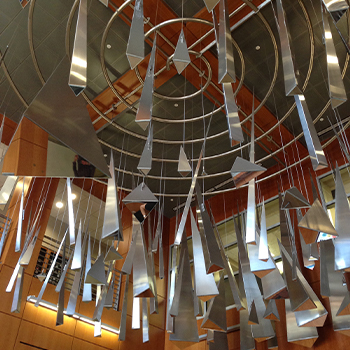
Axiom
Physical Science
Axiom
Kristin Jones/Andrew Ginzel
Stainless steel and mirror
2011
Axiom consists of 118 stainless steel tetrahedrons symbolizing the periodic table of elements. The art is designed to include future additions of tetrahedron elements to the work, as advancements in science are made. Kristin Jones and Andrew Ginzel have worked collaboratively since 1985 on public and private commissions.
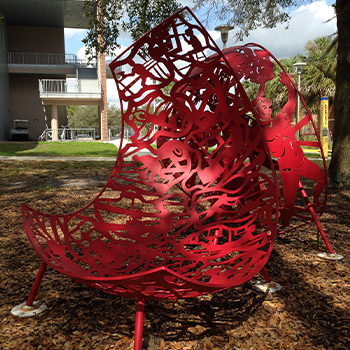
Cyclorama
Performing Arts Center-Theatre
Cyclorama
Joe O’Connell/Blessing Hancock
Powder coated and stainless steel
2012
Cyclorama is a series of interactive, illuminated sculptures that serve as a contemporary stage set for shadow theatre. The public is invited to walk, sit and relax amongst the forms whose surfaces tell archetypal origin stories. At night colored lights prokect strong silhouettes onto the surrounding trees and visitors, creating the effect of being surrounded by a panoramic theater production.
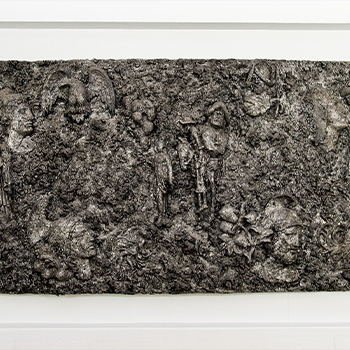
Power of Passage
Performing Arts Center-Theatre
Power of Passage
Johann Eyfells
Aluminum
1994
Eyfells was born in Iceland and moved to Florida in 1969, where he was a professor of art at UCF for over 30 years. He produces abstract sculptures based on his experiments in chemistry and physics, using metals such as aluminum, iron and copper. The volcanic landscape of Iceland is a strong influence in his work.
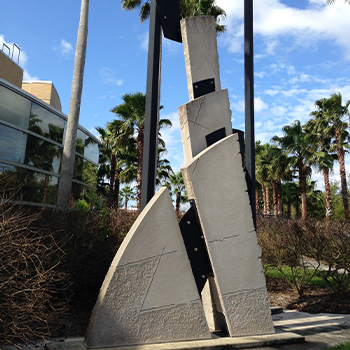
Hermes Gate
Recreation and Wellness
Hermes Gate
Dale Enochs
Indiana limestone, steel, and gold leaf
2011
Hermes Gate, Dale Enochs, Hermes Gate, Indiana limestone, steel and gold leaf, 2011, Enochs’ preferred material is limestone. Enochs enjoys “the challenges of creating large scale work and I love doing site-specific work…Scale is one of the many formal elements of art that I draw from. It is a tool used in building a composition of thoughts, ideas and emotions.”
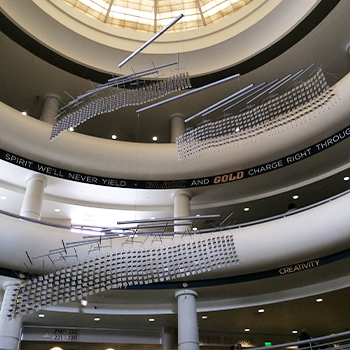
Trio
Student Union
Trio
Tim Prentice
Aluminum & Stainless Lexan
1996
This work is suspended from a single wire and consists of three major parts that are carefully balanced and rotate with precision. Prentice’s sculpture is inspired by the tradition of kinetic works by Alexander Calder and George Rickey.
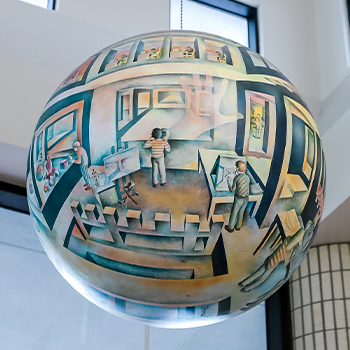
Rounding Off the Edges
Visual Arts Building
Rounding Off the Edges
Richard Termes
Acrylic paint on acrylic sphere
1992
Termes uses a six point perspective system that he devised to create unique paintings on large spheres called Termespheres. His imagery is influenced by M.C. Escher and Buckminster Fuller.
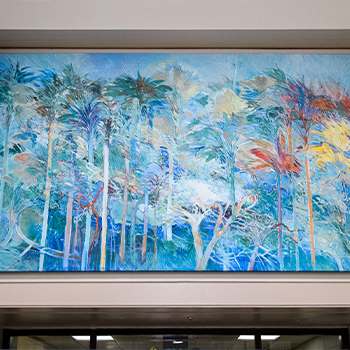
Florida Song
Visual Arts Building
Florida Song
Craig Rubadoux
Oil on canvas
1992
Rubadoux primarily works on paper and canvas. His paintings are intensely personal glimpses into particular emotions, and he frequently speaks of his work as a journal. Greatly affected by his environment and a love of nature, Rubadoux.
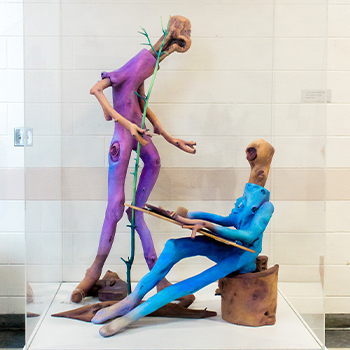
The Drawing Lesson
Visual Arts Building
The Drawing Lesson
Cheryl Bogdanowitsch
Painted wood
1992
These figurative sculptures are inspired by the artist’s life-long interest in the natural world and sculptors Mia Westerlund Roosen and James Surls. As Bogdanowitsch states, “My central Florida environment of trees and lakes provides me with both the inspiration and the materials for my work. My work has evolved from my personal life, my environment, and my metaphysical studies.”

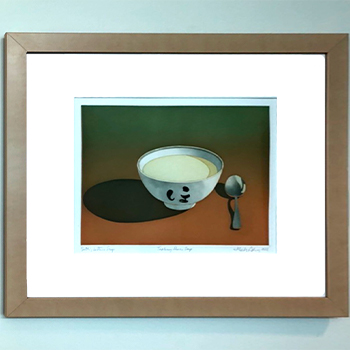
Beth’s Soup
Research Park
Beth’s Soup
Mark Adams
Etching
1982
Mark Adams, now remembered for his luminous watercolors, began his career as a designer of tapestries, as well as stained glass pieces for liturgical buildings in America. He was also skilled in a variety of art forms, including mosaics, printmaking, drawing, and oil painting. In 1975, Adams grew frustrated with his craft and his lack of complete control over the creative process, and devoted himself to painting in the hopes of creating small, intimate works. Adams realized that with watercolor, he could best apply his knowledge and techniques of working in flat planes of luminous and translucent color. His favorite subjects were quotidian or nostalgic objects or scenes borrowed directly from his own life and memories.
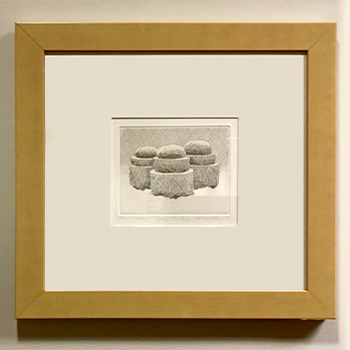
Filoli Topiary
Research Park
Filoli Topiary
Mark Adams
Etching
1983
Mark Adams, now remembered for his luminous watercolors, began his career as a designer of tapestries, as well as stained glass pieces for liturgical buildings in America. He was also skilled in a variety of art forms, including mosaics, printmaking, drawing, and oil painting. In 1975, Adams grew frustrated with his craft and his lack of complete control over the creative process, and devoted himself to painting in the hopes of creating small, intimate works. Adams realized that with watercolor, he could best apply his knowledge and techniques of working in flat planes of luminous and translucent color. His favorite subjects were quotidian or nostalgic objects or scenes borrowed directly from his own life and memories.
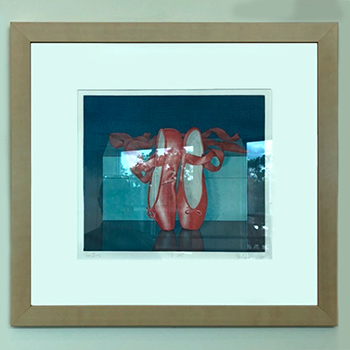
Toe Shoes
Research Park
Toe Shoes
Mark Adams
Etching
1993
Mark Adams, now remembered for his luminous watercolors, began his career as a designer of tapestries, as well as stained glass pieces for liturgical buildings in America. He was also skilled in a variety of art forms, including mosaics, printmaking, drawing, and oil painting. In 1975, Adams grew frustrated with his craft and his lack of complete control over the creative process, and devoted himself to painting in the hopes of creating small, intimate works. Adams realized that with watercolor, he could best apply his knowledge and techniques of working in flat planes of luminous and translucent color. His favorite subjects were quotidian or nostalgic objects or scenes borrowed directly from his own life and memories.
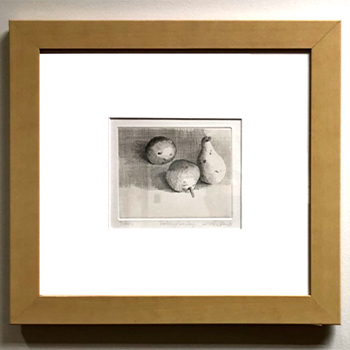
3 Pears
Research Park
3 Pears
Mark Adams
Etching
1983
Mark Adams, now remembered for his luminous watercolors, began his career as a designer of tapestries, as well as stained glass pieces for liturgical buildings in America. He was also skilled in a variety of art forms, including mosaics, printmaking, drawing, and oil painting. In 1975, Adams grew frustrated with his craft and his lack of complete control over the creative process, and devoted himself to painting in the hopes of creating small, intimate works. Adams realized that with watercolor, he could best apply his knowledge and techniques of working in flat planes of luminous and translucent color. His favorite subjects were quotidian or nostalgic objects or scenes borrowed directly from his own life and memories.
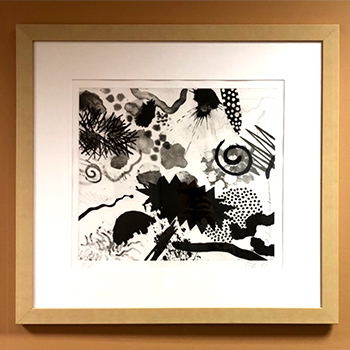
Gooeyduck
Research Park
Gooeyduck
Peter Alexander
Etching
1982
Peter Alexander is a contemporary American sculptor who was a part of the Light and Space movement along with Robert Irwin and Larry Bellduring the 1960s. His best known works are sculptures constructed from translucent plastic and resin, which respond to the light of the spaces in which they are shown. “I’m a romantic, and I believe in it. I believe in the value of things,” the artist has said. “I believe that objects can be made that can have an extraordinary effect on me and others.” Born on February 27, 1939 in Los Angeles, CA, he studied architecture in England before receiving both his BFA and MFA from the University of California, Los Angeles. Alexander started as an architect, before developing a reputation in the 1960s for creating his sculptures. More recently, he has shown himself to be a prolific painter, with many of his paintings depicting the landscape and night skyline of Los Angeles. Alexander currently lives and works in Santa Monica, CA. The artist’s works are held in the collections of the J. Paul Getty Museum in Los Angeles, The Museum of Modern Art in New York, and the Walker Art Center in Minneapolis.
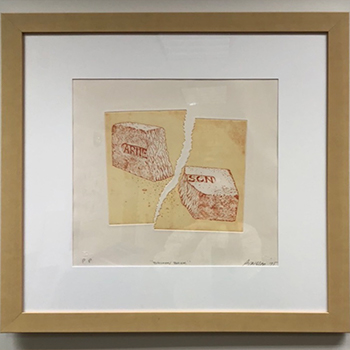
Broken Brick
Research Park
Broken Brick
Robert Arneson
Etching
1977
He was born on September 4, 1930 in Benicia, CA and studied at California College of the Arts after working as a cartoonist for a local newspaper. Robert Arneson was an American sculptor and ceramicist who is considered as the father of Funk Art, the anti-establishment movement that incorporated a mélange of found objects, autobiographical subjects, and humor. He died on November 2, 1992 in Benicia, CA from liver cancer, and his works can be found in major institutions around the world including including the Chicago Art Institute, the Hirshhorn Museum and Sculpture Garden in Washington, D.C., the Metropolitan Museum of Art in New York, and the Smithsonian American Art Museum in Washington, D.C.
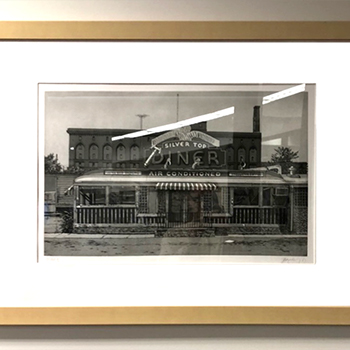
Silver Top
Research Park
Silver Top
John Baeder
Etching
1987
John Baeder is known for paintings and prints of roadside diners. In the 1950’s he was highly influenced from road trips to and from Atlanta and Auburn University where he was a fine arts student. His work was part of the post-war realist movement and is linked to 18th century Romanticism, specifically the genre of “grand tour” travel paintings.
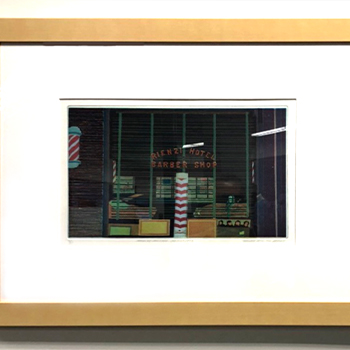
Barbershop
Research Park
Barbershop
Timothy Berry
Etching
1974
Timothy Berry has been a practicing artist for over 30 years. His paintings, drawings, and prints have been exhibited extensively in museums and galleries throughout the United States and Europe, including 21 solo and 75 group exhibitions. He is also a dedicated art educator, having taught and lectured at university level for 33 years. He is presently on the faculty of the San Francisco Art Institute.
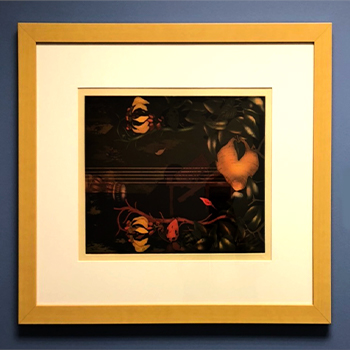
Culture Mine
Research Park
Culture Mine
Timothy Berry
Etching
1991
Timothy Berry has been a practicing artist for over 30 years. His paintings, drawings, and prints have been exhibited extensively in museums and galleries throughout the United States and Europe, including 21 solo and 75 group exhibitions. He is also a dedicated art educator, having taught and lectured at university level for 33 years. He is presently on the faculty of the San Francisco Art Institute.
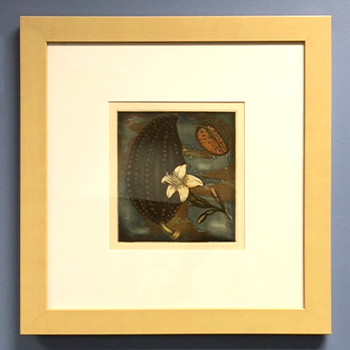
Details
Research Park
Details
Timothy Berry
Etching
1991
Timothy Berry has been a practicing artist for over 30 years. His paintings, drawings, and prints have been exhibited extensively in museums and galleries throughout the United States and Europe, including 21 solo and 75 group exhibitions. He is also a dedicated art educator, having taught and lectured at university level for 33 years. He is presently on the faculty of the San Francisco Art Institute.
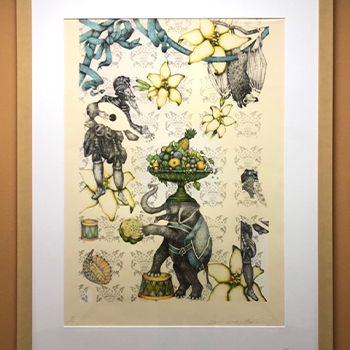
Restoration Repose
Research Park
Restoration Repose
Timothy Berry
Etching
1991
Timothy Berry has been a practicing artist for over 30 years. His paintings, drawings, and prints have been exhibited extensively in museums and galleries throughout the United States and Europe, including 21 solo and 75 group exhibitions. He is also a dedicated art educator, having taught and lectured at university level for 33 years. He is presently on the faculty of the San Francisco Art Institute.
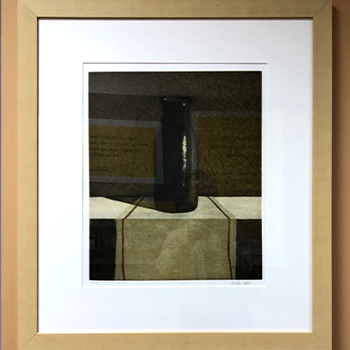
Milk Bottle
Research Park
Milk Bottle
Gordon Cook
Etching
1982
Gordon Cook, printmaker, painter, sculptor, and educator, was born in Chicago on October 3, 1927. Between 1945 and 1950, he was enrolled in studies at Illinois Wesleyan University where he earned his BFA. Cook studied intaglio printmaking with Vera Berdich in 1949 and attended S.W. Hayter’s lectures at the School of the Art Institute of Chicago. He relocated to Iowa City in 1950 for graduate studies in printmaking with Mauricio Lasansky.
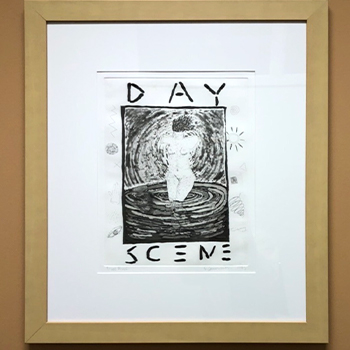
Day Scene
Research Park
Day Scene
Squeak Cornwath
Etching
1983
Squeak Carnwath draws upon the philosophical and mundane experiences of daily life in her paintings and prints, which can be identified by lush fields of color combined with text, patterns, and identifiable images. She has received numerous awards including the Society for the Encouragement of Contemporary Art (SECA) Award from San Francisco Museum of Modern Art, two Individual Artist Fellowships from the National Endowment for the Arts, a Guggenheim Fellowship, the Award for Individual Artists from the Flintridge Foundation, and the Lee Krasner Lifetime Achievement Award from the Pollock-Krasner Foundation. In 2019, she was inducted into the National Academy of Design and Art. Carnwath is Professor Emerita at the University of California, Berkeley. She lives and works in Oakland, CA.
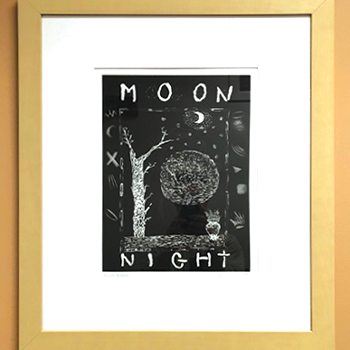
Moon Night
Research Park
Moon Night
Squeak Carnwath
Etching
1983
Squeak Carnwath draws upon the philosophical and mundane experiences of daily life in her paintings and prints, which can be identified by lush fields of color combined with text, patterns, and identifiable images. She has received numerous awards including the Society for the Encouragement of Contemporary Art (SECA) Award from San Francisco Museum of Modern Art, two Individual Artist Fellowships from the National Endowment for the Arts, a Guggenheim Fellowship, the Award for Individual Artists from the Flintridge Foundation, and the Lee Krasner Lifetime Achievement Award from the Pollock-Krasner Foundation. In 2019, she was inducted into the National Academy of Design and Art. Carnwath is Professor Emerita at the University of California, Berkeley. She lives and works in Oakland, CA.

Ice
Research Park
Ice
Robert Cottingham
Etching
1975
Robert Cottingham is an American painter best known for his Photorealist depictions of cropped commercial signage. Born in Brooklyn, NY, Cottingham studied at Pratt Institute, where he received his BFA in 1963 before starting a five-year career in commercial advertising. Upon moving to Los Angeles Cottingham seriously committed himself to his own painting practice, which eventually subsumed his advertising career by 1968 as the artist rose to prominence along with the Photorealist movement. Cottingham is considered among the 13 most prominent Photorealists of the latter half of the 20th century—he disavowed his relationship to the movement. Instead, he views his own work as part of the lineage of vernacular Americana painters, including the likes of Stuart Davis and Edward Hopper. .

Untitled
Research Park
Untitled
Laddie John Dill
Monotype
1982
A central figure in the California Light and Spacemovement, Laddie John Dill has been crafting light and earthy materials like concrete, glass, sand, and metal into luminous sculptures, wall pieces, and installations since the 1970s. Referring to his choice of materials, Dill explains: “I was influenced by [Robert] Rauschenberg, Keith Sonnier,Robert Smithson, Dennis Oppenheim, and Robert Irwin, who were working with earth materials, light, and space as an alternative to easel painting.” Among his most celebrated works is an untitled installation from 1971, for which Dill filled a gallery with mounds of pale sand, topped with precisely arranged glass panels illuminated by the soft, green glow of argon lighting set just beneath the surface. When he does use canvas, he paints with pigments derived from cement and natural oxides.

Untitled
Research Park
Laddie John Dill
Etching
1982
A central figure in the California Light and Spacemovement, Laddie John Dill has been crafting light and earthy materials like concrete, glass, sand, and metal into luminous sculptures, wall pieces, and installations since the 1970s. Referring to his choice of materials, Dill explains: “I was influenced by [Robert] Rauschenberg, Keith Sonnier,Robert Smithson, Dennis Oppenheim, and Robert Irwin, who were working with earth materials, light, and space as an alternative to easel painting.” Among his most celebrated works is an untitled installation from 1971, for which Dill filled a gallery with mounds of pale sand, topped with precisely arranged glass panels illuminated by the soft, green glow of argon lighting set just beneath the surface. When he does use canvas, he paints with pigments derived from cement and natural oxides.
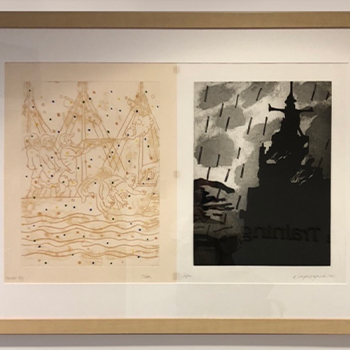
Now and Then
Research Park
Now and Then
Rupert Garciá
Etching
1991
Deeply entrenched in the activist communities of the San Francisco Bay Area, renowned poster-maker Rupert Garcia creates artwork that synthesizes his political background with a graphic, pop sensibility. Garcia came of age in the post-’68 era, creating screenprints, drawings, and pastel paintings of subject matter drawn from documentary photographs and paintings, and inflected with his political affiliations. Garcia rendered figures like Frida Kahlo or unnamed political prisoners with the bold colors and sharp lines of Warhol or Lichtenstein. Applying the apolitical style of pop to political icons, Garcia melds the sometimes-dissonant aesthetic and social currents of his time. Among his influences are the Mexican muralists Diego Rivera, Jose Clemente Orozco, and David Siqueiros.
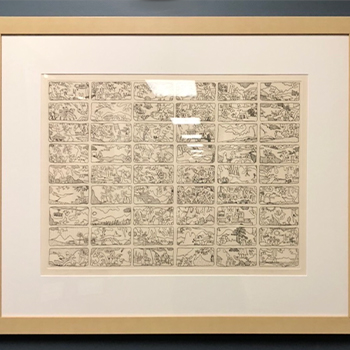
Early Riser
Research Park
Early Riser
John Himmelfarb
Etching
1977
John Himmelfarb is an American painter, draftsman, and printmaker. Born in Chicago, Illinois, he grew up in a household of artists (his parents being artists) surrounded by their art and the countryside that inspired them. John finished his undergraduate studies at Harvard University in liberal arts with a major in architectural sciences. He opened a studio in Chicago in 1970 and has worked primarily in Chicago since that time.
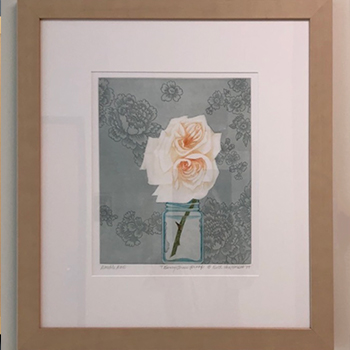
Double Rose
Research Park
Double Rose
Beth Van Hoesen
Etching
1982
Beth Van Hoesen was born in Boise, Idaho. She moved with her family to California, and in 1944, enrolled at Stanford University to study fine arts, earning a Bachelor of Arts degree in 1948. Van Hoesen’s work uses realism and tonality to create bold images of animals and botanicals, she accomplishes this by building up color through the process of etching. Van Hoesen distinguished herself as a draftsman and printmaker throughout her career. She was honored with numerous awards and solo exhibitions at museums and recognized by a multitude of institutions.

Hibiscus
Research Park
Hibiscus
Beth Van Hoesen
Etching
1982
Beth Van Hoesen was born in Boise, Idaho. She moved with her family to California, and in 1944, enrolled at Stanford University to study fine arts, earning a Bachelor of Arts degree in 1948. Van Hoesen’s work uses realism and tonality to create bold images of animals and botanicals, she accomplishes this by building up color through the process of etching. Van Hoesen distinguished herself as a draftsman and printmaker throughout her career. She was honored with numerous awards and solo exhibitions at museums and recognized by a multitude of institutions.
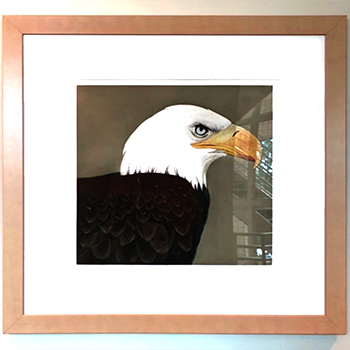
Ichi
Research Park
Ichi
Beth Van Hoesen
Etching
1982
Beth Van Hoesen was born in Boise, Idaho. She moved with her family to California, and in 1944, enrolled at Stanford University to study fine arts, earning a Bachelor of Arts degree in 1948. Van Hoesen’s work uses realism and tonality to create bold images of animals and botanicals, she accomplishes this by building up color through the process of etching. Van Hoesen distinguished herself as a draftsman and printmaker throughout her career. She was honored with numerous awards and solo exhibitions at museums and recognized by a multitude of institutions.
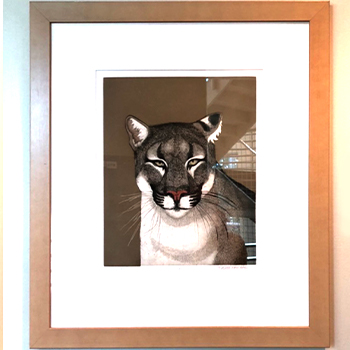
Maharani
Research Park
Maharani
Beth Van Hoesen
Etching
1989
Beth Van Hoesen was born in Boise, Idaho. She moved with her family to California, and in 1944, enrolled at Stanford University to study fine arts, earning a Bachelor of Arts degree in 1948. Van Hoesen’s work uses realism and tonality to create bold images of animals and botanicals, she accomplishes this by building up color through the process of etching. Van Hoesen distinguished herself as a draftsman and printmaker throughout her career. She was honored with numerous awards and solo exhibitions at museums and recognized by a multitude of institutions.
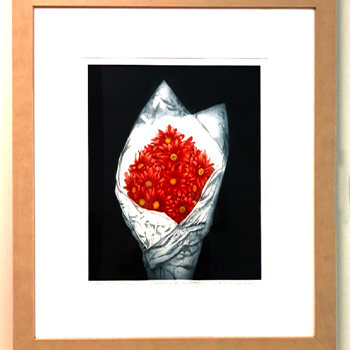
Wrapped Flowers
Research Park
Wrapped Flowers
Beth Van Hoesen
Etching
1985
Beth Van Hoesen was born in Boise, Idaho. She moved with her family to California, and in 1944, enrolled at Stanford University to study fine arts, earning a Bachelor of Arts degree in 1948. Van Hoesen’s work uses realism and tonality to create bold images of animals and botanicals, she accomplishes this by building up color through the process of etching. Van Hoesen distinguished herself as a draftsman and printmaker throughout her career. She was honored with numerous awards and solo exhibitions at museums and recognized by a multitude of institutions.
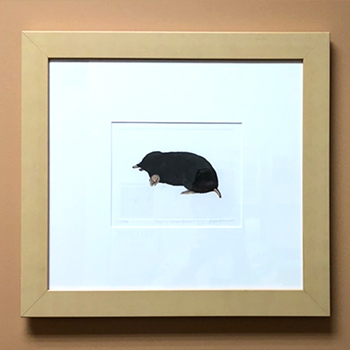
Mole
Research Park
Mole
Beth Van Hoesen
Etching
1982
Beth Van Hoesen was born in Boise, Idaho. She moved with her family to California, and in 1944, enrolled at Stanford University to study fine arts, earning a Bachelor of Arts degree in 1948. Van Hoesen’s work uses realism and tonality to create bold images of animals and botanicals, she accomplishes this by building up color through the process of etching. Van Hoesen distinguished herself as a draftsman and printmaker throughout her career. She was honored with numerous awards and solo exhibitions at museums and recognized by a multitude of institutions.
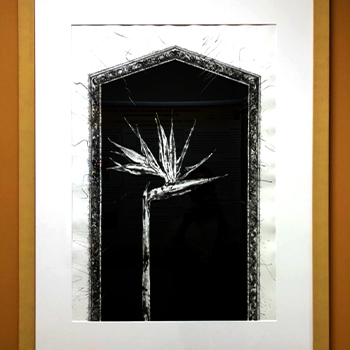
Black Bird
Research Park
Black Bird
Victoria Nodiff
Etching
1981
Victoria Nodiff-Netanel has been a horsewoman all her life. From pretending to be a horse as a kid in Wisconsin to painting photorealistic horses at California Institute of the Arts, from toy horses to competing in dressage at the Intermediaire level, Victoria has always known the magic of horses. In 2007, after many years of competing in dressage, Victoria shifted gears when a little horse came into her life. She realized that she wanted to help people with this miniature horse and she immediately started training Pippin, putting all her years of horsemanship to work.
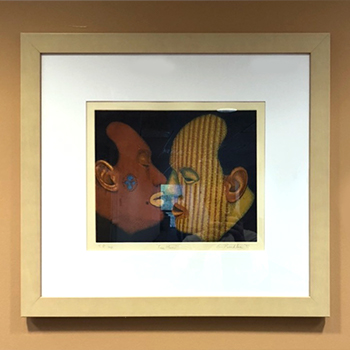
Free Man
Research Park
Free Man
Ed Paschke
Etching
1996
Highly influenced by the photo-based portraiture of Andy Warhol, Ed Paschke created portraits modeled from images sourced from popular media and American subcultures. By the aid of an opaque project. He was one of the first artists to paint using this technology—Paschke combined separate features culled from newspapers, tabloids, television, and pornographic magazines into single compositions. His early work was known for parodying celebrities and portraying marginal members of society; he later transitioned from recognizable subjects to anonymous, masked characters who appeared to be distorted by a malfunctioning television.
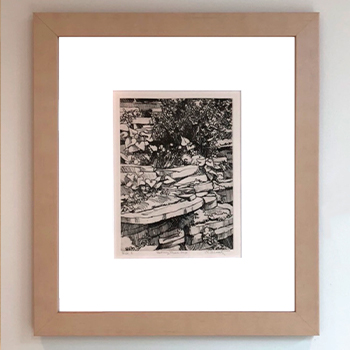
R.G. #1
Research Park
R.G. #1
Carl Schwartz
Etching
1978
Carl Schwartz, born in Detroit, Michigan, is a painter and print-maker, who currently resides in Fort Myers, Florida. He is a realist, whose work shows the influence of both abstract expressionism and cubism. For almost thirty years, Schwartz taught figure drawing and painting in Chicago at the North Shore Art League, until moving to Florida in 1984. There he resumed teaching at Edison Community College and at Florida Gulf Coast University. At the home he shares with his wife Dinah Schwartz, he raises Koi, a type of Oriental goldfish, which, along with water lilies, are often subjects in his art.
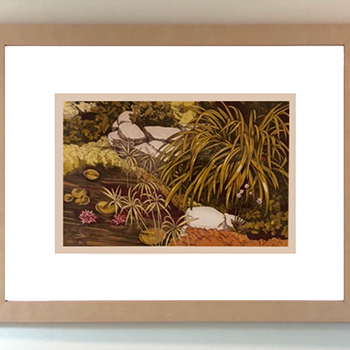
Water Palms
Research Park
Water Palms
Carl Schwartz
Etching
1976
Carl Schwartz, born in Detroit, Michigan, is a painter and print-maker, who currently resides in Fort Myers, Florida. He is a realist, whose work shows the influence of both abstract expressionism and cubism. For almost thirty years, Schwartz taught figure drawing and painting in Chicago at the North Shore Art League, until moving to Florida in 1984. There he resumed teaching at Edison Community College and at Florida Gulf Coast University. At the home he shares with his wife Dinah Schwartz, he raises Koi, a type of Oriental goldfish, which, along with water lilies, are often subjects in his art.
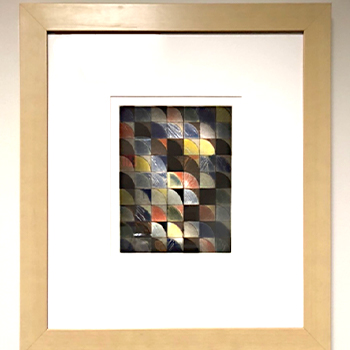
Winterhill
Research Park
Winterhill
Ann Thornycroft
Etching
1983
Ann Thornycroft was born and raised in the English countryside, drawing on her experiences and memories of nature as the basis for her abstract compositions. Thornycroft is best known for her large-scale, gridded compositions, though the execution of these works varies in rigidity and expressiveness. In explaining her use of this structure, the artist wrote, “The grid symbolized nature and man. It is a very simple device but it continues to capture my interest.” Recurring motifs in Thornycroft’s work also include overlapping circular forms and arcs that resemble botanical forms.
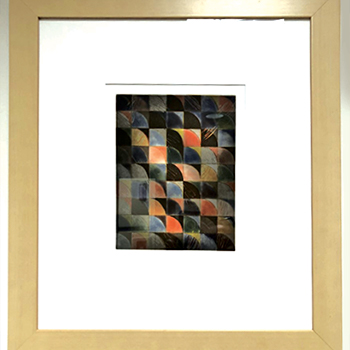
Woodnish
Research Park
Woodnish
Ann Thornycroft
Etching
1983
Ann Thornycroft was born and raised in the English countryside, drawing on her experiences and memories of nature as the basis for her abstract compositions. Thornycroft is best known for her large-scale, gridded compositions, though the execution of these works varies in rigidity and expressiveness. In explaining her use of this structure, the artist wrote, “The grid symbolized nature and man. It is a very simple device but it continues to capture my interest.” Recurring motifs in Thornycroft’s work also include overlapping circular forms and arcs that resemble botanical forms.
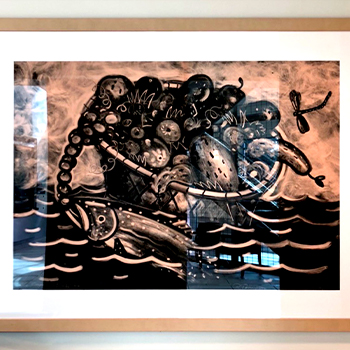
Rise Form
Research Park
Rise Form
Richard Thompson
Monotype
1992
Since Richard Thompson began painting in the 1960’s, he has used a visual vocabulary of landscape and still life images. Now, fifty years later, those images continue to mature. The paintings grow from all that he sees and all that he thinks about in the world around him. Over the last decade Richard has explored the rural, agricultural landscape of the American west with its distant horizons, far away mountains, geometric field patterns and farm buildings seen as if they are still life elements on a wide, vast table.
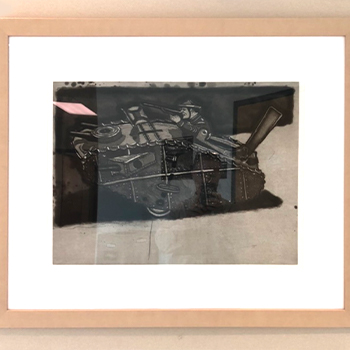
Toy Tank II
Research Park
Toy Tank II
Robert Weaver
Etching
1974
With a highly expressionistic and very personal vision, Weaver has become one of the Midwest’s most celebrated artists. Weaver was born in Stilwell Kansas, and received his BA from the Kansas City Art Institute and his BFA from the University of New Mexico in 1965. He went on to receive his MFA from the University of Nebraska-Lincoln in 1968. Weaver has worked in a variety of mediums and techniques: ink, charcoal, lithograph, oil paint, woodcut, pencil and pastel. Though he briefly experimented with abstraction in the 1950s and 1960s, Weaver is best known for his realistic and intimate portraiture and subjects taken from nature. These works are deeply connected to his own history and his experiences growing up in rural Kansas.
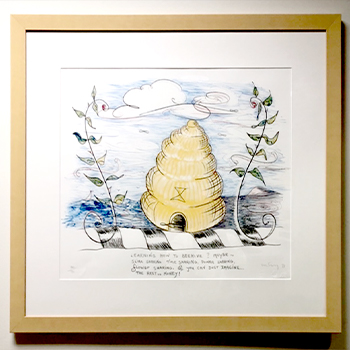
Beehive
Research Park
Beehive
William T. Wiley
Lithograph
1998
William T. Wiley is a contemporary American artist. Maintaining an eclectic practice that has been associated with the Funk Art movement, Wiley incorporates drawing, painting, sculpture, performance, and filmmaking into his work. His paintings act as an aggregate and are composed of a wide range of obsessive marks, materials, and mediums, frequently layered on top of a map or other information-coded images. Often featuring illustrations of fantastical universes, his works contain both historical literary references and integrate geometric abstraction. Born in Bedford, IN on October 21, 1937, he earned both his BFA and MFA from the California School of Fine Arts shortly before joining the UC Davis Art faculty in 1963, where he would instruct and influence prominent artists like Bruce Nauman. Wiley has enjoyed widespread acclaim and success, participating in both the Venice and Whitney Biennials in 1980 and 1983, respectively. His work is held in many important collections, such as the Art Institute of Chicago, The Museum of Modern Art in New York, and the Smithsonian American Art Museum in Washington, D.C. The 2009–2010 exhibition “What’s It All Mean: William T. Wiley in Retrospect,” offered a comprehensive retrospective of Wiley’s career.
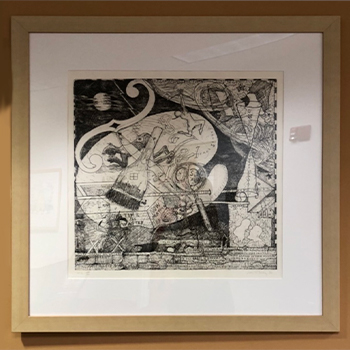
Planks Pool
Research Park
Planks Pool
William T. Wiley
Etching
1980
William T. Wiley is a contemporary American artist. Maintaining an eclectic practice that has been associated with the Funk Art movement, Wiley incorporates drawing, painting, sculpture, performance, and filmmaking into his work. His paintings act as an aggregate and are composed of a wide range of obsessive marks, materials, and mediums, frequently layered on top of a map or other information-coded images. Often featuring illustrations of fantastical universes, his works contain both historical literary references and integrate geometric abstraction. Born in Bedford, IN on October 21, 1937, he earned both his BFA and MFA from the California School of Fine Arts shortly before joining the UC Davis Art faculty in 1963, where he would instruct and influence prominent artists like Bruce Nauman. Wiley has enjoyed widespread acclaim and success, participating in both the Venice and Whitney Biennials in 1980 and 1983, respectively. His work is held in many important collections, such as the Art Institute of Chicago, The Museum of Modern Art in New York, and the Smithsonian American Art Museum in Washington, D.C. The 2009–2010 exhibition “What’s It All Mean: William T. Wiley in Retrospect,” offered a comprehensive retrospective of Wiley’s career.
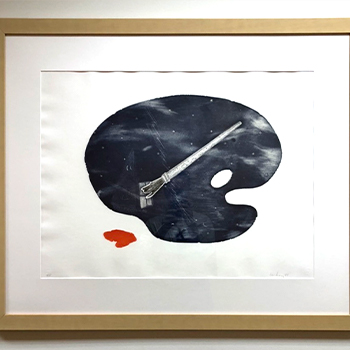
O.T.P.A.G for P.G.
Research Park
O.T.P.A.G for P.G.
William T. Wiley
Etching
1981
William T. Wiley is a contemporary American artist. Maintaining an eclectic practice that has been associated with the Funk Art movement, Wiley incorporates drawing, painting, sculpture, performance, and filmmaking into his work. His paintings act as an aggregate and are composed of a wide range of obsessive marks, materials, and mediums, frequently layered on top of a map or other information-coded images. Often featuring illustrations of fantastical universes, his works contain both historical literary references and integrate geometric abstraction. Born in Bedford, IN on October 21, 1937, he earned both his BFA and MFA from the California School of Fine Arts shortly before joining the UC Davis Art faculty in 1963, where he would instruct and influence prominent artists like Bruce Nauman. Wiley has enjoyed widespread acclaim and success, participating in both the Venice and Whitney Biennials in 1980 and 1983, respectively. His work is held in many important collections, such as the Art Institute of Chicago, The Museum of Modern Art in New York, and the Smithsonian American Art Museum in Washington, D.C. The 2009–2010 exhibition “What’s It All Mean: William T. Wiley in Retrospect,” offered a comprehensive retrospective of Wiley’s career.

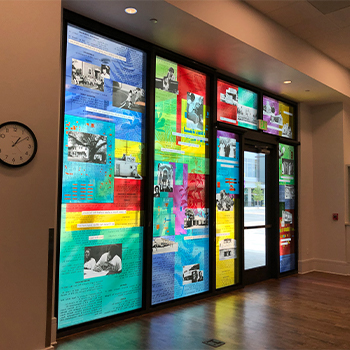
Of History and Hope
UCF Downtown
Of History and Hope
NANCY GUTKIN O’NEIL (b. 1949)
“If we can truly remember, they will not forget.”
Miller Williams, “Of History and Hope”
from Some Jazz A While: Collected Poems
Tempered and laminated float glass with fired-in pigments. Fabrication by Glasmalerei Peters, Paderborn, DE. Completed January, 2020.
Six panels. Each Transom, 30½” h x 52¼” w. Each Sidelight, 104½” h x 29” w.
Each large panel, 138” h x 51” w. The glass is ½” thick.
Purchased 2020 with funds provided by Florida’s Art in State Buildings Program
(F.S. 255.043)
I titled my artwork with the last line of the Miller Williams poem, “Of History and Hope”. That’s what this piece is about.
I grew up in Brooklyn, NY and graduated from Sarah Lawrence College. I lived in rural Maine for many years, and now live in New Orleans. I’ve been a glass artist for almost 40 years, and produce work in my own studio and with fabricators. My public art projects are in many parts of the country.

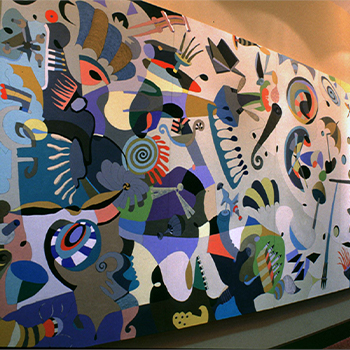
Infinite Possibilities
Rosen Campus
Infinite Possibilities
Carla Rossi Poindexter
8′ x 28′ acrylic painting on canvas in seven interlocking panels
2004
Poindexter writes, “My work is a personal response to the time in which we exist and our place in that time. It is a viewpoint that engages my imagination by including what I understand about science, poetry, language, movement, time, and human interactions by filtering them all into an act of understanding and responding. In Infinite Possibilities, I confront macro- and micro-space, shape, and color as they interlock in a unified place. The air that surrounds the objects of this world is sometimes more important than those objects themselves. All of these object-characters are important, but would be nothing without the plasma they exist within.”
